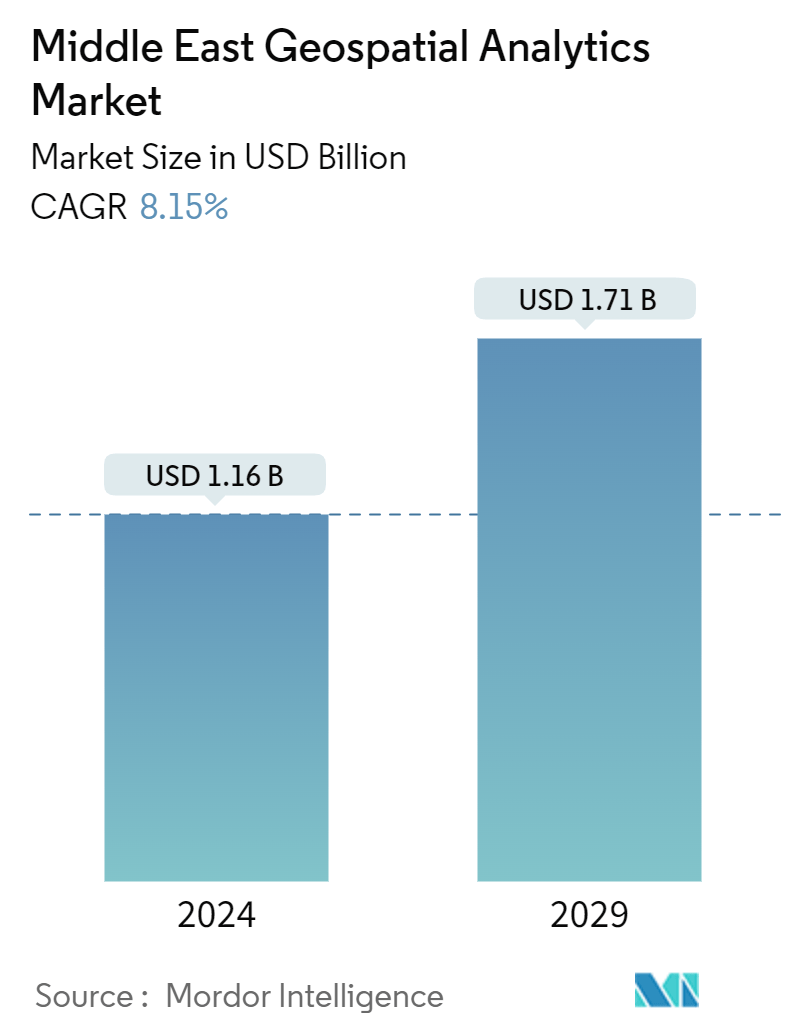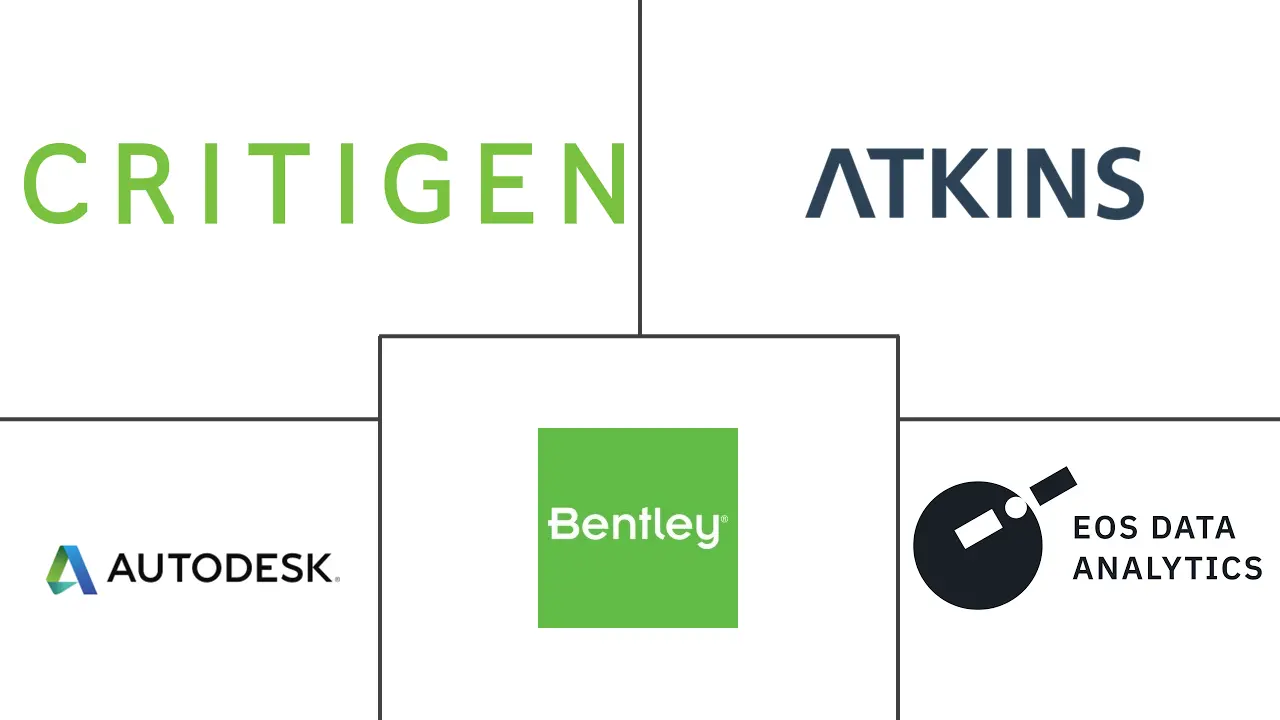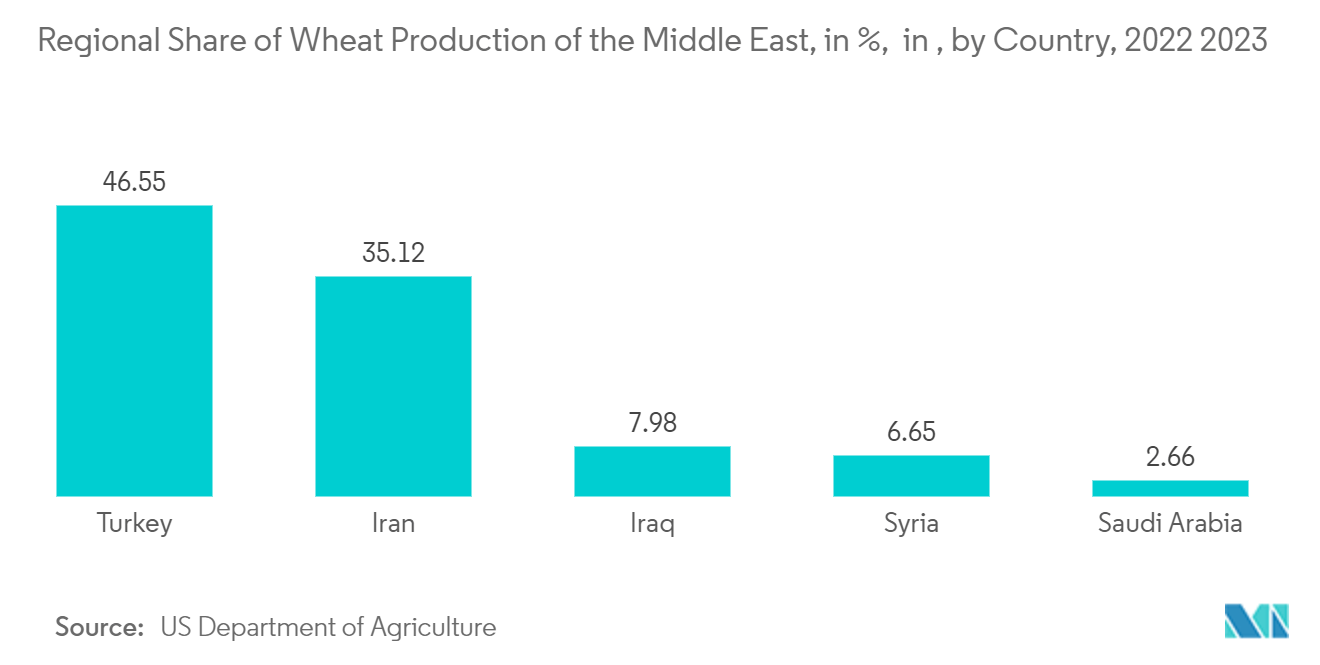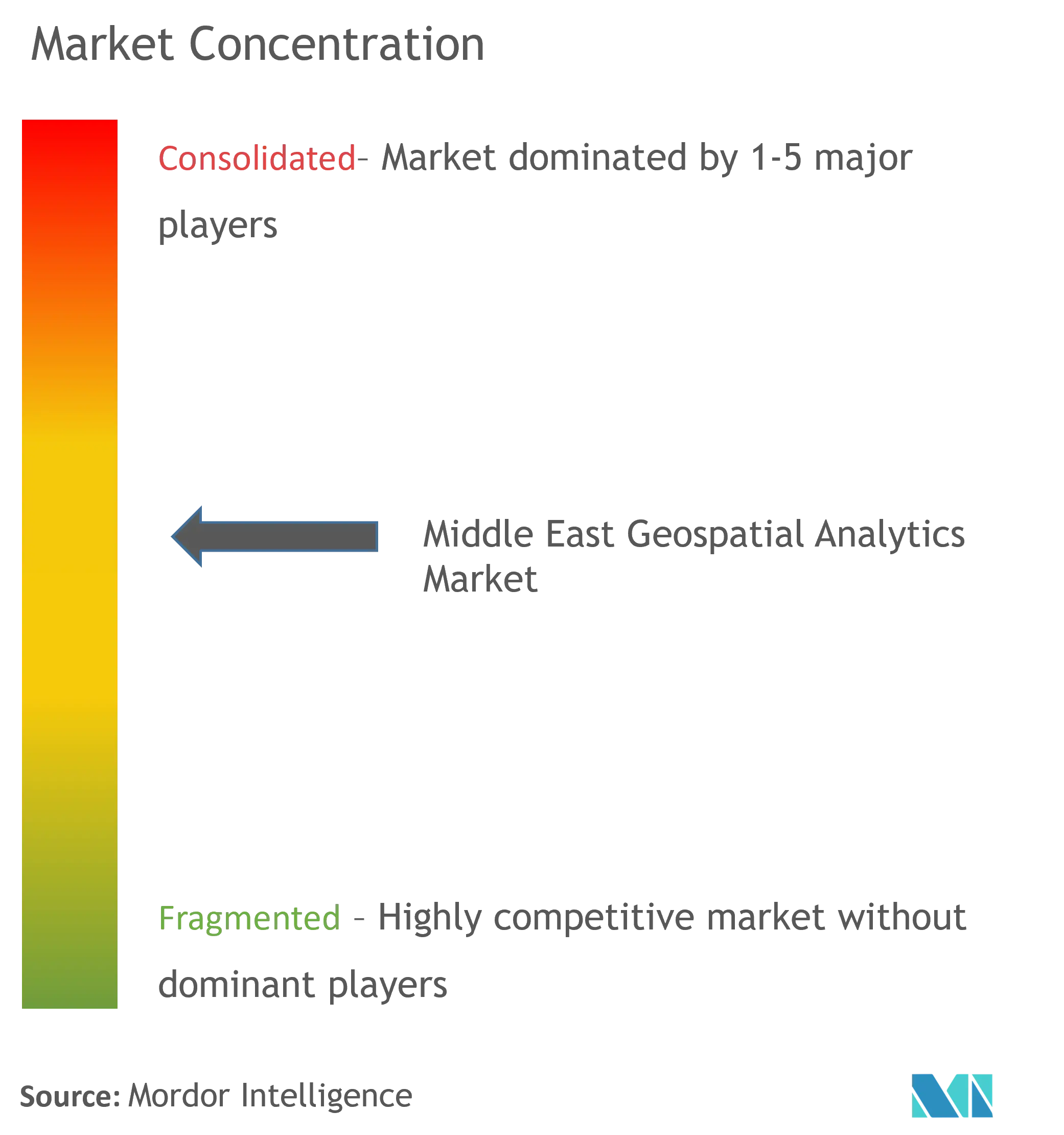Middle East Geospatial Analytics Market Size

| Study Period | 2019 - 2029 |
| Base Year For Estimation | 2023 |
| Market Size (2024) | USD 1.16 Billion |
| Market Size (2029) | USD 1.71 Billion |
| CAGR (2024 - 2029) | 8.15 % |
| Market Concentration | Medium |
Major Players
*Disclaimer: Major Players sorted in no particular order |
Middle East Geospatial Analytics Market Analysis
The Middle East Geospatial Analytics Market size is estimated at USD 1.16 billion in 2024, and is expected to reach USD 1.71 billion by 2029, growing at a CAGR of 8.15% during the forecast period (2024-2029).
Geospatial analysis refers to a broad range of activities that emphasize applying various techniques to data comprising geographical or space-related characteristics. Some of the key factors driving the development of the geospatial analytics market include the increasing use of GPS devices, technological advances in the field of GIS technology, recent trends in integration and convergence of geospatial technologies, the advent of new corporation models aimed at leveraging the demand for geospatial information, and increased application of geospatial analytics in city and town planning.
- Network analysis has gained prominence in today's cities, which are becoming increasingly congested. For instance, in the case of any emergency response system (ERS), the best route or shortest path analysis data using spatial data directly improves the fire emergency response, police station emergency response, healthcare emergency response system, etc. Google Maps extensively uses spatial data to provide multiple routes, the best routes, and real-time analysis to re-route if the user cannot follow the suggested path.
- Furthermore, network analysis is significant for utility companies operating in cities with complex network asset management problems. It helps companies efficiently design and model complex network infrastructures for supplying electrical, telecommunications, gas, and water to consumers using spatial data.
- The UAE Space Agency, the Israeli Ministry of Innovation, Science and Technology, and the Israel Space Agency are inviting universities and research institutes in the United Arab Emirates and Israel to submit joint research proposals based on data from the Israeli Vegetation and Environment Monitoring New Micro Satellite (VENS), which monitors the earth's environment and vegetation. The recommendations will be part of the Environment Monitoring Joint Research Project.
- This Earth observation program collects data using space-based remote sensing and contributes to necessary scientific research on our planet. The UAE and Israel Space Agency will contribute USD 200,000 to the selected research project. Initiatives like these would create an opportunity for the studied market to grow.
- In addition to this, with the advent of satellite remote sensing, global navigation satellite systems (GNSS), aerial surveys using photographic cameras, digital cameras, sensor networks, radar, and LiDAR, the volume of geospatial data has grown exponentially with data production.
- Big Data application workflow, thus, enables filtering, transformation, extraction, and other pre-processing operations on geospatial data, including raster imagery. High-volume, high-velocity data from multiple sources, such as sensors, satellites, mobile mapping, and location feeds from mobile devices, can be aggregated in the Big Data applications and processed to identify relevant high-value data.
- High costs and operational concerns, such as the limited presence of open standards and interoperability mechanisms and integration issues between ERM and GIS systems, hinder the geospatial analytics market's adoption rate. Although the overall costs of geospatial analysis solutions have decreased drastically since the turn of the decade, owing to the greater availability of open-source tools and plunging hardware costs, it remains a major concern for small and medium-scale companies. Generic location-based data is readily available over the Internet; however, it offers limited demographic insights and is not completely useful for making strategic decisions.
Middle East Geospatial Analytics Market Trends
Surface Analysis is Expected to Hold Significant Share of the Market
- Surface or terrain analysis focuses on studying topography-related information, such as aspect, volume, slope, hydrology, and other relevant characteristics. Surface analysis is widely used in disaster mitigation and location planning, as they effectively use esoteric mapping to determine the probability of disasters. The general surface characteristics (such as slope, aspect, and curvature) are largely used for analyzing the variations in the surface of a study object.
- For instance, the 'slope' metric is extensively used to define the areas of a region that are highly prone to landslides, whereas 'curvature' is used to determine areas prone to damage. In addition, the slope aspect can be used with geological structures to assess rock beds that may be useful for planning roads and other constructions, especially in hilly terrains. Furthermore, the 'slope' metric is extensively used to define the areas of a region that are highly prone to landslides, whereas 'curvature' is used to determine areas prone to damage.
- Furthermore, visibility analysis is conducted to identify areas during location planning, in which case, locations with expansive views are recognized as vantage points. Surface analysis is also widely used during the construction/renovation of large sites, wherein the volume of materials required to be dumped in open areas to avert erosion is determined.
- The increasing development of smart cities across the region is one of the key factors driving the market's growth. The increasing development of smart cities across the region is one of the key factors driving the market's growth. For instance, according to experts during an online event, Qatar Free Zones Authority (QFZA) is concentrating its business development efforts on attracting, partnering with, and investing in global enterprises to construct technological clusters to assist the country in accomplishing its goals. In Qatar, two large smart cities of the future are now under construction: Msheireb Downtown, a USD 5.5 billion mixed-use area encompassing 31,000 square meters, and Lusail Metropolis, a USD 45 billion smart city covering 38 square kilometers.
- The collaboration of firms to explore regional geothermal resources would drive the demand for surface analysis. For instance, in November 2022, SLB is cooperating with Oman's Ministry of Energy and Minerals and the Oman Investment Authority in creating a national strategy to expand the possibility of Oman's geothermal resources. This information follows the completion of an extensive project to assess data from more than 7,000 oil, gas, and water wells to map sweet spots for geothermal opportunities in the country. Commissioned by the Omani management, the SLB specialists assessed surface, subsurface, and well data from the national data repository over three months.
- Surface analysis can be further used for ecological zoning, land suitability classification, and probability mapping. Agricultural suitability and probability of soil erosion are two examples where geospatial data may be extensively used to best use the available land and limited agricultural labor. For instance, according to the US Department of Agriculture, Turkey was the leading contributor to regional wheat production within the Middle East region, with a share of 46.55 percent, as of the marketing year 2022/2023.

Utility and Communication is Expected to Hold Significant Share of the Market
- Utility and Communication is a prominent end-user industry that has adopted geospatial analytics. The segment contains mostly energy and power, and communication systems. Analytic techniques used in the sector determine energy consumption profiles of high-resolution buildings using a method that combines annual energy simulations of various city-specific prototypical assets and geospatial data from the Geographical Information System (GIS) framework.
- The United Arab Emirates introduced "Energy Policy 2050," the nation's first comprehensive supply-and-demand-based energy strategy. The strategy intends to save AED 700 billion by 2050 and boost the share of renewable energy in the whole energy mix from 25% to 50%. It also aspires to lower the carbon footprint of power generation by 70%. Additionally, it aims to improve corporate and individual consumption efficiency by 40%. Such policies by the government will significantly create an opportunity for the market to grow.
- The increase in electricity production will drive the studied market. For instance, in July 2022, By 2025, Iraq was to generate more than 41,000 megawatts (MW) of power because of new initiatives and plans to upgrade existing utilities. When domestic power demand is anticipated to reach 41,225 MW in 2025, the cabinet has authorized a "plan" to meet that objective. As local demand is anticipated to reach that level in 2025, the policy aims to grow the nation's overall power production to 41,225 MW.
- According to Dubai Electricity and Water Authority, In 2023, the total electricity consumption by the commercial sector of the emirate of Dubai in the United Arab Emirates exceeded approximately 27,368 terawatt-hours. The number of electricity consumers in Dubai exceeded one million in the same year. Such huge consumption would increase the construction of new power plants, proportionately raising the demand for the studied market.
- Communications companies are taking the help of geospatial analytics to determine the location of new cell phone tower installations. Geospatial data obtained from the devices is used to measure signal strength from particular towers in that location, and the range of that signal is used to understand the lack of coverage and signal strength. Various parameters, like population density, road positioning, and customer location, are considered when deciding the location of the new cell tower installation.

Middle East Geospatial Analytics Industry Overview
The Middle East Geospatial Analytics market is moderately consolidated with players like Atkins, Autodesk, Inc., Bentley, Systems, Inc., Critigen Llc, Eos Data Analytics, Inc. Etc. The companies continuously invest in strategic partnerships and product developments to gain substantial market share. Some of the recent developments in the market are:
In July 2023, the Iranian Space Agency's (ISA) spokesperson, Hossein Daliriyan that the country's Khayyam satellite has commenced remote sensing activities to monitor and map land use changes. In collaboration with the Information Technology Organization of Iran (ITO), the ISA is working on legal procedures to prepare and present the initial batch of satellite images to judicial authorities combating land expropriation. Under an existing memorandum of understanding between the ISA and the ITO, the latter requested more precise data and observation of land surfaces through the satellite to address legal disputes between ordinary citizens and state entities.
In May 2023. Microsoft introduced three new functions for geospatial analysis in Azure Data Explorer, geo_point_buffer, geo_line_buffer, and geo_polygon_buffer. These functions allow you to create polygonal buffers around geospatial points, lines, or polygons, respectively, and return the resulting geometry. Users can use these functions to perform spatial operations such as intersection, containment, distance, or proximity on user geospatial data or to visualize data on maps.
Middle East Geospatial Analytics Market Leaders
-
Atkins
-
Autodesk, Inc.
-
Bentley Systems, Inc.
-
Critigen Llc
-
Eos Data Analytics, Inc.
*Disclaimer: Major Players sorted in no particular order

Middle East Geospatial Analytics Market News
June 2023: Autodesk and Esri's partnership accelerated innovations in AEC. Autodesk's InfoWater Pro and Esri's ArcGIS Pro were integrated to make this possible, and there are many more examples of how their partnership with Esri enables BIM and GIS data to flow between respective solutions seamlessly. The result is that project stakeholders can now visualize, understand, and analyze infrastructure within its real-world context.
February 2023: Mercedes-Benz and Google announced a long-term strategic partnership to accelerate auto innovation and create the industry's next-generation digital luxury car experience. With this partnership, Mercedes-Benz will be the first automaker to build its branded navigation experience based on new in-car data and navigation capabilities from the Google Maps Platform. This will give the luxury automaker access to Google's leading geospatial offering, including detailed information about places, real-time and predictive traffic information, automatic rerouting, and more.
Middle East Geospatial Analytics Market Report - Table of Contents
1. INTRODUCTION
- 1.1 Study Assumptions and Market Definition
- 1.2 Scope of the Study
2. RESEARCH METHODOLOGY
3. EXECUTIVE SUMMARY
4. MARKET INSIGHTS
- 4.1 Market Overview
-
4.2 Industry Attractiveness - Porter's Five Forces Analysis
- 4.2.1 Bargaining Power of Buyers
- 4.2.2 Bargaining Power of Suppliers
- 4.2.3 Threat of New Entrants
- 4.2.4 Threat of Substitutes
- 4.2.5 Intensity of Competitive Rivalry
- 4.3 Industry Value Chain Analysis
- 4.4 Assessment of the Impact of COVID-19 on the Market
5. MARKET DYNAMICS
-
5.1 Market Drivers
- 5.1.1 Increasing in Demand for Location Intelligence
- 5.1.2 Advancements of Big Data Analytics
-
5.2 Market Restraints
- 5.2.1 High Costs and Operational Concerns
- 5.2.2 Concerns related to Geoprivacy and Confidential Data
6. MARKET SEGMENTATION
-
6.1 By Type
- 6.1.1 Surface Analysis
- 6.1.2 Network Analysis
- 6.1.3 Geovisualization
-
6.2 By End-user Vertical
- 6.2.1 Agriculture
- 6.2.2 Utility and Communication
- 6.2.3 Defense and Intelligence
- 6.2.4 Government
- 6.2.5 Mining and Natural Resources
- 6.2.6 Automotive and Transportation
- 6.2.7 Healthcare
- 6.2.8 Real Estate and Construction
- 6.2.9 Other End-user Verticals
-
6.3 By Country
- 6.3.1 United Arab Emirates
- 6.3.2 Turkey
- 6.3.3 Saudi Arabia
7. COMPETITIVE LANDSCAPE
-
7.1 Company Profiles
- 7.1.1 Atkins
- 7.1.2 Autodesk, Inc.
- 7.1.3 Bentley Systems, Inc.
- 7.1.4 Critigen Llc
- 7.1.5 Eos Data Analytics, Inc.
- 7.1.6 Esri, Inc. (Environmental Systems Research Institute)
- 7.1.7 Fugro
- 7.1.8 General Electrical Company
- 7.1.9 Google, Inc.
- 7.1.10 Harris Corporation
- *List Not Exhaustive
8. INVESTMENT ANALYSIS
9. MARKET OPPORTUNITIES AND FUTURE TRENDS
** Subject To AvailablityMiddle East Geospatial Analytics Industry Segmentation
Geospatial analytics is acquiring, manipulating, and displaying imagery and data from the geographic information system (GIS), such as satellite photos and GPS data. The specific identifiers of a street address and a zip code are used in geospatial data analytics. They are used to create geographic models and data visualizations for more accurate trends modeling and forecasting.
The Middle East geospatial analytics market is segmented by type (surface analysis, network analysis, geovisualization), by end user vertical (agriculture, utility and communication, defence and intelligence, government, mining and natural resources, automotive and transportation, healthcare, real estate, and construction), by country (United Arab Emirates, Turkey, Saudi Arabia). The market sizes and forecasts regarding value (USD) for all the above segments are provided.
| By Type | Surface Analysis |
| Network Analysis | |
| Geovisualization | |
| By End-user Vertical | Agriculture |
| Utility and Communication | |
| Defense and Intelligence | |
| Government | |
| Mining and Natural Resources | |
| Automotive and Transportation | |
| Healthcare | |
| Real Estate and Construction | |
| Other End-user Verticals | |
| By Country | United Arab Emirates |
| Turkey | |
| Saudi Arabia |
Middle East Geospatial Analytics Market Research Faqs
How big is the Middle East Geospatial Analytics Market?
The Middle East Geospatial Analytics Market size is expected to reach USD 1.16 billion in 2024 and grow at a CAGR of 8.15% to reach USD 1.71 billion by 2029.
What is the current Middle East Geospatial Analytics Market size?
In 2024, the Middle East Geospatial Analytics Market size is expected to reach USD 1.16 billion.
Who are the key players in Middle East Geospatial Analytics Market?
Atkins, Autodesk, Inc., Bentley Systems, Inc., Critigen Llc and Eos Data Analytics, Inc. are the major companies operating in the Middle East Geospatial Analytics Market.
What years does this Middle East Geospatial Analytics Market cover, and what was the market size in 2023?
In 2023, the Middle East Geospatial Analytics Market size was estimated at USD 1.07 billion. The report covers the Middle East Geospatial Analytics Market historical market size for years: 2019, 2020, 2021, 2022 and 2023. The report also forecasts the Middle East Geospatial Analytics Market size for years: 2024, 2025, 2026, 2027, 2028 and 2029.
Middle East Geospatial Analytics Industry Report
Statistics for the 2024 Middle East Geospatial Analytics market share, size and revenue growth rate, created by Mordor Intelligence™ Industry Reports. Middle East Geospatial Analytics analysis includes a market forecast outlook to for 2024 to 2029 and historical overview. Get a sample of this industry analysis as a free report PDF download.



